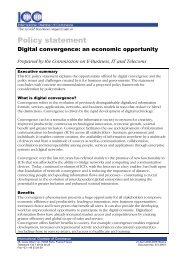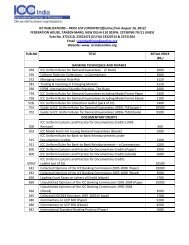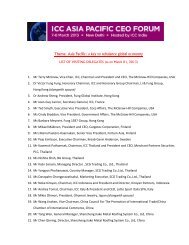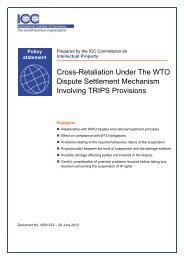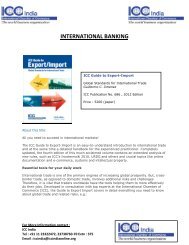2013 - ICC India
2013 - ICC India
2013 - ICC India
- No tags were found...
Create successful ePaper yourself
Turn your PDF publications into a flip-book with our unique Google optimized e-Paper software.
70<strong>ICC</strong> BANKING COMMISSION | <strong>2013</strong> GLOBAL RISKS TRADE FINANCE | APPENDIX C128 In this treatment we allocate defaulted exposure in a year based on the observed ratioof recoveries and write-offs. So for example if defaulted exposure was 200 and we hadreported recoveries of 180 and reported write-offs of 120, then we have estimated recoveriesas 120 (=200 x 180 / (180+120)), to produce an estimated recovery rate of 60%, compared toan estimated recovery rate of 90% (=180/200) under the current approach (this is broadlyspeaking what has happened with the Loans for Import figures). However this does notalways “reduce” the observed recovery rate – for example, if defaulted exposure was 200,reported recoveries were 60 and reported write-offs were 40, then the result would be arecovery rate of approximately 60% vs. 30% under our current approach (this is broadlywhat has happened for the Import L/C figures).129 For example, in a draft paper on wholesale LGD to the Credit Risk Standing group (whichis a forum for discussion of credit risk issues between the FSA and the UK banks), the FSAhas indicated that “firms should assume that we would not approve any discount ratesfor downturn LGD below 9% for UK assets”. It is understood that this reflects a potentialdownturn discount rate if a future downturn was a high-interest rate downturn.130 The specific formula can be found at §320 of BCBS (2006).131 The two fields used from the Trade Register in deriving this are “Total cumulative exposure(USD) per product type for calendar year” and “Total exposure (USD) per product type as atbalance sheet”132 In reality, given the low default rates in our data, the impact of ignoring defaults is minimal.For example, with the 6% default rate used in the earlier example, the impact would be tochange the estimate of average maturity from 0.25 years to 0.24 years.133 For example, if trade finance products were generally written to mature before the end ofthe calendar year, then this might result in us underestimating the maturity as the year-endsnapshot would not have a representative proportion of products.134 We have not had the opportunity to review and discuss these results with the banks in detailand would note that whilst there was generally good alignment in the different measures ofImport and Export Confirmed L/Cs, there was significant variability in the results reportedfor Loans for Import and Loans for Export.DISCLAIMERThe information in this report, or upon which this report is based, has been obtainedfrom sources the authors believe to be reliable and accurate. However, it has notbeen independently verified and no representation or warranty, express or implied, ismade as to the accuracy or completeness of any information contained in this reportobtained from third parties. Readers are cautioned not to rely on these statements.The <strong>ICC</strong> and its project adviser, Oliver Wyman, undertake no obligation to reviseor update any statements, whether as a result of new information, future events orotherwise, and they shall in no event have any liability in respect of this report nor beliable for any loss or damage arising in connection with the use of the information inthis report.



